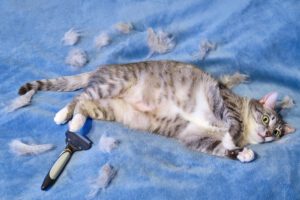Are Cat Hairballs Normal?
Cats are diligent groomers. As they clean their coats, they swallow loose hairs. These hairs can form what we commonly call a hairball. Scientifically termed “trichobezoars,” hairballs are clumps of undigested hair mixed with stomach contents. Most often, these clumps pass through the digestive system and are expelled during defecation. However, sometimes they are regurgitated, leading to the familiar (and somewhat unpleasant) scene many cat owners recognize.

The Frequency and Common Signs Hairballs in cats are relatively common, especially in long-haired breeds like Maine Coons or Persians. If your feline friend coughs up a hairball occasionally, it’s generally not a cause for alarm. Here’s what you might notice:
- Regurgitating a tubular mass: It’s not a pleasant sight, but finding a tubular-shaped mass (often mistaken for feces) is a tell-tale sign of a hairball.
- Retching, gagging, or vomiting: Before expelling a hairball, your cat might display some retching or gagging behavior. It’s their body’s way of getting the obstruction out.
- Constipation or diarrhea: Sometimes, instead of being regurgitated, hairballs move into the intestine and may cause constipation or diarrhea.
When Should You Be Concerned?
While the occasional hairball is normal, frequent hairballs can be a sign of underlying issues. Some causes of concern include:
- Frequency: If your cat is producing hairballs more than once a month, it’s a good idea to consult with a vet.
- Other Symptoms: Watch out for signs like lethargy, reduced appetite, or unexplained weight loss accompanying hairballs.
- Persistent coughing or retching without producing a hairball: This can be a sign of a blockage, which requires immediate medical attention.
Prevention is Key
There are several strategies to help reduce the frequency and occurrence of hairballs in cats:
- Regular grooming: By brushing your cat frequently, especially if they have long hair, you can prevent excessive swallowing of loose hairs.
- Hairball formulas: Some cat foods are specially designed to reduce hairballs. They help improve skin and coat health, reducing shedding and supporting digestive health.
- Hydration: Ensure your cat has access to fresh water at all times. Hydration can help in passing the hair through the digestive system.
Consult with Groveport Canal Animal Hospital If you’re concerned about your cat’s hairballs, or simply want more information tailored to your pet’s specific needs, it’s always best to consult with a professional. Our experienced team at Groveport Canal Animal Hospital in Groveport, OH is here to provide the guidance and care your furry friend deserves. Call us at (614) 836-3222 or use the online form to book an appointment today.
Cats and hairballs have long been associated, and while the occasional hairball is normal, it’s essential to recognize when it might be indicative of a more significant issue. By staying informed, regularly grooming, and consulting with the veterinary professionals at Groveport Canal Animal Hospital, you can ensure the health and happiness of your feline companion.

